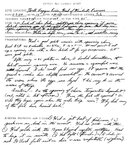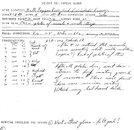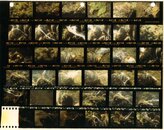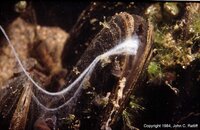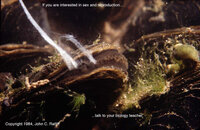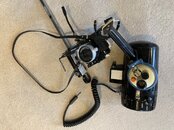Here is the other dive log entry, the earlier one on May 28, 1984. Note that the first 10 photos were not of the mussels spawning, but rather of the other mussels and insect life. I'm also using cursive writing in these, but realize that they are now 39 years old, and I still have them. I'm not sure our computerized dive logs off our dive computers will still be around in 39 years.
Now, I show a contact sheet which shows the photos described in the first dive log above. So compare the two (the dive log above and the contact sheet here). The contact sheet is a sheet of photographic paper onto which all the negatives are placed, the sheet exposed, and developed. That way, all the pictures on a 36 exposure film can be captured on one sheet. The Picture Machine in Roseburg, Oregon was able to do this for all film, but using color negative film worked best.
I've included two of the photos too. These were shot on ISO 100 Kodacolor film, 36 exposures, with my Nikonos II camera. I used the 35mm Nikonos lens, and a 1:4 extension tube with a wire framer. These extension tubes fit between the lens and camera body, extending the lens to film distance, which means that the focus is very, very close to the outside of the lens. In this case, what is on the film is 1/4th life size on the film. It makes for very good, sharp macro photos. I used a Subsea 150 strobe, set on 100 watt-seconds for the strobe strength. This is a manual exposure, and the lens setting was either F-16 or F-22, which produces the maximum depth-of-field. Exposure was changed by changing the distance of the strobe-to-subject, by holding the strobe either very close or further away. All this was manual exposures, and the Nikonos synch speed was no greater thas 1/60th of a second (all exposure were 1/60th second, but slower is possible with the strobe lighting).
Now, I have one photo here, titled "Mussel Spawning & Biology" which is a kinda tongue-in-cheek reference to learning about biology and sex from a biology teacher.
The last photo shows the actual equipment that I used for these photos. It is the Nikonos II with a 35mm lens, extension tube with the wire framer, and the Subsea 150 strobe. Note the white sticker on the strobe, which shows exposure lens settings for various film ASA (ISO), distance and strobe settings (there were three: 50, 100 and 150 watt-seconds).
Now, all this is done for the photographer, but we got very good photos before digital cameras by knowing a bit about photography.
SeaRat




